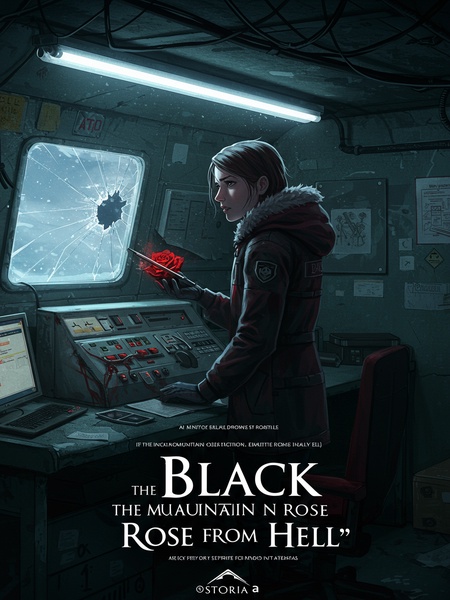Chapter 1: The Shockwave
A magnitude 12 earthquake at the South Pole sent shockwaves around the world, upending life for hundreds of millions.
That number alone was staggering—nearly the population of the entire United States. It hit me like a punch to the gut. My hands went numb around my phone, breath coming shallow as I tried to process the headline. Just imagining that many lives suddenly thrown into chaos by the earth itself turning against us made my head spin.
An international team of experts was dispatched to investigate, only to discover a bizarre, conical mountain had appeared at the South Pole.
This wasn’t some distant geological curiosity. Every major news outlet—CNN, NBC, even late-night hosts—couldn’t stop replaying that first satellite image. The mountain was jet black against the endless white, so sharply defined it almost seemed unreal. Jimmy Fallon tried to crack a joke about the black mountain, but even he looked shaken.
Emergency rooms overflowed with panic attacks. Headlines blared stories of people jumping from Wall Street rooftops or locking themselves in suburban basements, convinced the world was ending.
Suicide hotlines were overwhelmed. The sense of the world unmoored was everywhere—people abandoning jobs, students wandering out of class, stock markets see-sawing in pure panic. It felt like Y2K panic, 9/11, and the pandemic all rolled into one, only worse.
A handful of experts who remained clear-headed issued a joint appeal to all humanity:
At all costs, leave Earth immediately.
The message flashed on every device, every TV, even Times Square’s giant screens. The words themselves seemed to reverberate—leave Earth? Like a bad sci-fi script, except this was real.
1
My name is Mark Evans, and I’m an intern researcher at the Ohio State Earthquake Center.
Born and raised in Columbus, I’d dreamed of seeing my name on a peer-reviewed paper since high school. Now I was stuck mostly running seismic simulation models and re-filling the office Keurig. The place always smelled faintly like burnt popcorn and cheap coffee.
On the night of November 11th—right after I’d closed out a Black Friday preview livestream and was about to head to bed—the center director called, ordering everyone to report in immediately.
I’d just wrangled a discount on noise-cancelling headphones. My phone buzzed with the center’s group chat: "ALL HANDS—HQ NOW." Grumbling, I pulled on jeans and a hoodie and drove through the drizzle. The streets looked abandoned, traffic lights blinking yellow over empty intersections—like the whole city was holding its breath. It had the feel of a snow day before the blizzard hits.
Rubbing my eyes, I walked into the conference room, only to learn that a magnitude 12 earthquake had struck Antarctica.
The tension in the air was thick, as if the building itself was holding its breath. Every face was glued to the screens.
Images from Earth observation satellites showed the Antarctic continent on the verge of collapse:
The satellite feeds were the stuff of nightmares: enormous rifts zigzagged across what had been a pristine sheet of ice, like lightning bolts frozen mid-strike. The room was silent except for the quiet whir of the projectors.
Cracks hundreds of miles long split the Antarctic ice sheet.
One image zoomed in: the crack looked wide enough to swallow a whole city block. I found myself instinctively measuring its size against Ohio Stadium. It was the only way my brain could make sense of something that big—comparing it to Saturday football, not science.
Magma spewed from the fissures, only to be doused by the frigid sea and snow, solidifying into vast fields of basalt.
The colors were surreal—fiery orange clashing with the blinding white and deep blue. Steam rose in massive columns, blotting out the landscape. I could almost feel the heat radiating off the images, even as the room felt colder by the minute.
It was a true song of ice and fire—the most powerful earthquake in human history, maybe even in the planet’s history.
Someone in the back murmured, “This is like something out of a movie.” Nobody laughed.
The center director frowned, pointing at the map:
"Seismic waves have already impacted South America, Australia, and Africa.
His pointer trembled slightly as he traced the shockwave’s path, his usual steady baritone sounding thinner than usual.
"Chile, Argentina, Brazil, and Uruguay are being hammered by massive tsunamis. The disaster in New Zealand is also extremely severe.
He didn’t sugarcoat any of it. There was no way to, given the grim live feeds showing waves swallowing whole coastlines.
"As for Africa, we haven’t received data yet, but the outlook is grim.
Someone cursed softly. For a moment, I thought about my cousin teaching English in Cape Town.
"The Feds want every state’s top people in D.C. tonight. No excuses."
That got everyone shifting in their seats. If D.C. was calling all hands, it was bigger than anything in our lifetimes.
"Once the aftershocks subside, you’ll fly to Antarctica to conduct post-quake surveys, collect data, assess the disaster, and more.
My stomach dropped. Antarctica wasn’t a place for rookies like me. But protocol was protocol, and no one argued.
"This is a catastrophe for all humanity; no one can stand by and do nothing."
I nodded along, the words ringing in my ears. I felt equal parts terrified and—strangely—excited. For the first time, the world really needed us.
Continue the story in our mobile app.
Seamless progress sync · Free reading · Offline chapters